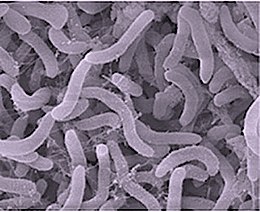
Back Pelagibacter ubique Catalan Candidatus Pelagibacter ubique German Pelagibacter ubique Spanish Pelagibacter ubique Finnish Candidatus Pelagibacter ubique French Pelagibacter ubique Galician ペラジバクター・ユビーク Japanese Candidatus Pelagibacter ubique Russian Pelagibacter ubique Ukrainian 遍在遠洋桿菌 Chinese
| "Candidatus Pelagibacter communis" | |
|---|---|

| |
| Scientific classification (Candidatus) | |
| Domain: | |
| Phylum: | |
| Class: | |
| Subclass: | |
| Order: | |
| Family: | |
| Genus: | "Candidatus Pelagibacter" Rappé et al. 2002
|
| Species: | "Ca. P. communis"
|
| Binomial name | |
| "Candidatus Pelagibacter communis" corrig. Rappé et al. 2002
| |
| Synonyms[1] | |
| |
"Candidatus Pelagibacter", with the single species "Ca. P. communis", was isolated in 2002 and given a specific name,[2] although it has not yet been described as required by the bacteriological code.[3] It is an abundant member of the SAR11 clade in the phylum Alphaproteobacteria. SAR11 members are highly dominant organisms found in both salt and fresh water worldwide and were originally known only from their rRNA genes, first identified in the Sargasso Sea in 1990 by Stephen Giovannoni's laboratory at Oregon State University and later found in oceans worldwide.[4] "Ca. P. communis" and its relatives may be the most abundant organisms in the ocean, and quite possibly the most abundant bacteria in the entire world. It can make up about 25% of all microbial plankton cells, and in the summer they may account for approximately half the cells present in temperate ocean surface water. The total abundance of "Ca. P. communis" and relatives is estimated to be about 2 × 1028 microbes.[5]
It is rod or crescent-shaped and one of the smallest self-replicating cells known, with a length of 0.37–0.89 μm and a diameter of only 0.12–0.20 μm. The Pelagibacter genome takes up about 30% of the cell's volume.[6] It is gram negative.[7] It recycles dissolved organic carbon. It undergoes regular seasonal cycles in abundance—in summer reaching ~50% of the cells in the temperate ocean surface waters. Thus it plays a major role in the Earth's carbon cycle.
Its discovery was the subject of "Oceans of Microbes", Episode 5 of "Intimate Strangers: Unseen Life on Earth" by PBS.[8]
- ^ Oren A. (2017). "A plea for linguistic accuracy—also for Candidatus taxa". Int J Syst Evol Microbiol. 67 (4): 1085–1094. doi:10.1099/ijsem.0.001715. PMID 27926819.
- ^ Michael S. Rappé; Stephanie A. Connon; Kevin L. Vergin; Stephen J. Giovannoni (2002). "Cultivation of the ubiquitous SAR11 marine bacterioplankton clade". Nature. 418 (6898): 630–633. Bibcode:2002Natur.418..630R. doi:10.1038/nature00917. PMID 12167859. S2CID 4352877.
- ^ List of Candidate species in LPSN; Parte, Aidan C.; Sardà Carbasse, Joaquim; Meier-Kolthoff, Jan P.; Reimer, Lorenz C.; Göker, Markus (1 November 2020). "List of Prokaryotic names with Standing in Nomenclature (LPSN) moves to the DSMZ". International Journal of Systematic and Evolutionary Microbiology. 70 (11): 5607–5612. doi:10.1099/ijsem.0.004332.
- ^ R. M. Morris, et al. (2002). "SAR11 clade dominates ocean surface bacterioplankton communities". Nature. 420 (6917): 806–810. Bibcode:2002Natur.420..806M. doi:10.1038/nature01240. PMID 12490947. S2CID 4360530.
- ^ "Candidatus Pelagibacter ubique." European Bioinformatics Institute. European Bioinformatics Institute, 2011. Web. 08 Jan. 2012. http://www.ebi.ac.uk/2can/genomes/bacteria/Candidatus_Pelagibacter_ubique.html Archived December 1, 2008, at the Wayback Machine
- ^ Stephen J. Giovannoni, H. James Tripp, et al. (2005). "Genome Streamlining in a Cosmopolitan Oceanic Bacterium". Science. 309 (5738): 1242–1245. Bibcode:2005Sci...309.1242G. doi:10.1126/science.1114057. PMID 16109880. S2CID 16221415.
- ^ "Archived copy" (PDF). Archived (PDF) from the original on 2006-03-05. Retrieved 2012-02-02.
{{cite web}}: CS1 maint: archived copy as title (link), Gauthier, Nicholas; Zinman, Guy; D'Antonio, Matteo; Abraham, Michael. Comparative Microbial Genomics DTU course. 2005. - ^ View "Oceans of Microbes" http://www.podcastdirectory.com/podshows/4339749 Archived 2012-02-17 at the Wayback Machine